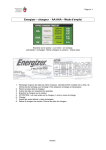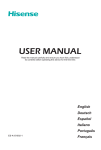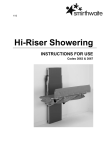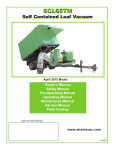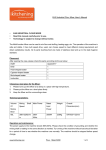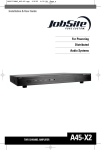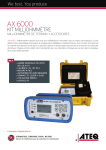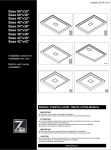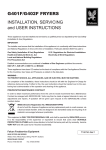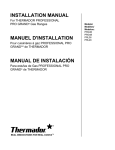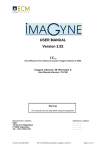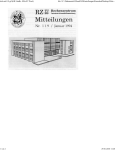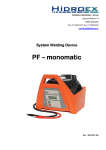Download S250/S350-CL ENERGIZER (HP)
Transcript
S250/S350-CL ENERGIZER (HP) ARCSPRAY POWER SUPPLY USER MANUAL PLEASE READ THIS MANUAL CAREFULLY BEFORE USE Metallisation Ltd Equipment Manual Amendment Register Issue No 1 Date 20/03/12 New Manual Description Of Modifications Section(s) Amended By Amended N/A R Campbell Before using the Equipment, read and understand this operating manual. In particular, refer to the Safety Precautions detailed in Section 2. Under NO circumstances should any modifications be made to the equipment without prior written approval from Metallisation CONTENTS SECTION 1 THE ENERGIZER 1.1 Description 1.2 Features 1.3 Specifications SECTION 2 SECTION 5 Maintenance and Repair 5.1 Routine Maintenance 5.2.1 Fuses 5.2.2 Diodes 5.2.3 Thermal Switch 5.2.4 Over Current Protection 5.2.5 Pressure Switch SAFETY PRECAUTIONS SECTION SECTION PREPARING THE ENERGIZER 3.1 Preliminary Check List 3.2 Handling Instructions 3.3 Connecting the Power Supply 3.4 Connecting the Air Supply 3.5 Attaching the Pistol 3.6 Loading the Wire from Mig Reels 3.7 Loading the Wire from Drums SECTION 6 3 4 OPERATING THE ENERGIZER 4.1 Starting to Spray 4.2 Shutting Down FAULT FINDING 6.1 No Nozzle Air 6.2 Air but No Voltage 6.3 Insufficient Voltage 6.4 Fan Stops SECTION 7 Useful Information 7.1 7.2 7.3 7.4 Recommended Spares Holding Spares List Circuit Diagrams Pneumatic Diagram SECTION THE ENERGIZER 1.1 1.2 1.3 Description Features Specifications 1 1. THE ENERGIZER S350 1.1 The Metallisation Energizer S250/S350 is an ergonomically designed Electric Arc Spraying Supply and Control Systems. It has been specially designed specifically for metal spraying and its benefits will be felt when used in conjunction with the full range of Metallisation Pistols. This single unit houses the electric and pneumatic controls for the system and can carry a removable wire dispensing system for all systems (optional) which is covered to protect against dust. 1.2 Features 1.2.1 The continuously variable spraying current is controlled by the motor speed control potentiometer to the drive motor. The spray current of the system is a guide to the material throughput and is infinitely variable up to its full nominal rating at 100% duty cycle i.e. 250A or 350A. The spray current can now be set, via a closed loop control, to a pre-defined value via the control pot. 1.2.2 The 3 phase Power Transformer and Variable Inductance Choke are designed to provide optimum arc characteristics and stability for any currently specified arc sprayed coating. 1.2.3 The 3 phase Switched Voltage Control gives finely stepped control over voltage and provides for reliable control under arduous conditions. This feature allows selection of the spraying voltage for all material or material combinations maintaining coating quality with the most robust circuitry. 1.2.4 The Atomising Airflow to the pistol spray head is continuously variable allowing control over the coating texture and the coating structure. 1.2.5 The purpose built Wire Dispensing System ensures that the wire follows the optimum line to the pistol and reduces dust contamination of the wire 1.2.6 As protection for both the equipment and the operator, electrical, thermal and air pressure cut-outs are provided. 1.2.7 Full Fan Assisted Cooling is provided for the transformers and rectifier. 1.2.8 System displays provide easy monitoring of the equipment. 1.2.9 A current sensor is fitted to the unit which limits the spray current to the maximum rated for the unit, i.e. 250A or 350A. 1.2.10 Two fixed and two braked castor wheels are provided which ease handling and improve the units mobility. 1.2.11 All the supplies from the Energizer to the spraying pistol e.g. power cables, air hoses, control cables etc. are all quick release fittings and issue near ground level as an aid to pistol handling. 1.3 SPECIFICATIONS S250/S350 ENERGIZER 1.3.1 OUTPUT CHARACTERISTICS Spraying Current S250 : Spraying Current S350 : 0-250A @ 100% Duty Cycle 0-350A @ 100% Duty Cycle Voltage : 0-50V dc (nominal) Atomising Air: 1.56³/min @5 bar (55cfm @ 90 psi) 1.3.2 INPUT REQUIREMENTS 1.3.2.1 Electricity: S250CL 380/415 VAC 3 Phase + Earth 50/60hz S350 CL 380/415/460 VAC 3 + Earth Phase 50/60hz S250 CL 200/220V 3 phase + Earth 50/60hz S350 CL 200/220 VAC Phase + Earth 50/60hz NOTE: The S250 Energizer for 380/415/460V input must be connected to a suitable isolator or switched socket protected by a suitable protective device rated at 20amps/ph The S250 Energizer for 200/220VAC input must be connected to a suitable isolator or switched socket protected by a suitable protective device rated at 45/40amps/ph The S350 Energizer for 380/415/460VAC input must be connected to a suitable isolator or switched socket protected by a suitable protective device rated at 32amps/ph The S350 Energizer for 200/220VAC input must be connected to a suitable isolator or switched socket protected by a suitable protective device rated at 60/55amps/ph THIS EQUIPMENT MUST BE CONNECTED TO EARTH. 1.3.2.2 Clean Dry Compressed Air Min:1.3.3 1.56m³/min @6 bar (55cfm @ 90 psi) DISPLAYS Current:- 0-400 Amp analogue Voltage:- 0-50 Volts analogue Atomising and Aux Air: 0-140psi (0-10 bar) analogue Mains Indicator: Red Neon Indicator 1.3.4 GENERAL 1.3.4.1 Dimensions S250/S350: Width (Inc Wheels): Length: Height (Inc Handle): 680mm 900mm 913mm 1.3.4.2 Weight (Inc. optional drive unit and wire dispenser) S250: 200Kg / S350: 238Kg 1.3.4.3 Power Rating: S250: 12KVA / S350: 16KVA 1.3.4.4 Power Factor: 0.85 Lag 1.3.4.5 Auxiliary Circuits: 110Vac and 24Vdc 1.3.4.6 Pressure Switch Setting: 30 psi (2.0 bar) 1.3.4.7 Tropicalisation: Standard SECTION 2 SAFETY PRECATIONS 2 SAFETY PRECAUTIONS This section outlining “Safety Precautions” has not been included because of any great dangers inherent in metal spraying operations, but like most industrial processes, malpractices and careless procedures can create hazards for personnel and damage equipment. 2.1 The mains supplies MUST be disconnected before removing any of the outer panels. This can be achieved as follows:a) Switch off the power at the supply point and remove the mains supply plug. b) Remove the fuses from each phase at the isolator or distribution board. 2.2 ALL maintenance or overhaul should be conducted by a fully qualified electrician. 2.3 NEVER spray onto hoses, cables or instruments. SECTION 3 PREPARING THE ENERGIZER 3.1 3.2 3.3 3.4 3.5 3.6 3.7 3.8 Preliminary Check List Handling Instructions Connecting the Power Supply Connecting the Air Supply Attaching the Pistol Loading the Wire Loading the Wire from Drums Optional Power Extension Trolley for the DUAEV 3.1 PRELIMINARY CHECK LIST 3.1.1 Remove any packing materials and ensure that the equipment has suffered no damage whilst in transit (See Conditions of Sale). 3.1.2 Check that the following items are available:a) b) c) d) 1 off 1 off 1 off 1 off - Energizer Wire Dispenser (if ordered as option) Connection for ¾” bore air hose Operating Manual 3.2 HANDLING INSTRUCTIONS 3.2.1 The Energizer must only be lifted from the base, under no circumstances should it be lifted by the handle or by the M12 thread that locates the dispenser spigot 3.2.2 Care must be taken if attempting to transport the Energizer by fork lift truck not to damage the underside of the unit 3.3 CONNECTING THE POWER SUPPLY 3.3.1 The Energizer should be connected a suitable power supply as defined in the specifications by a qualified electrician. 3.3.2 Position the Energizer in the area in which it is to be used taking in to consideration the environment in which it will be operated. 3.3.3 If it is intended that the Energizer be available to several locations, use suitable outlets in each area in preference to long trailing cables. . 3.3.4 If fitted remove the wire dispenser and drive unit from the top of the energizer. Remove the top rear panel from the energizer and attach the power cable to terminals 1, 2, 3 and the Earth. Check that the input voltage is correct for the unit, the voltage selector terminals (A) can be found beneath the top front panel, see power circuit EN210. Note: Terminals shown below are dependent on the unit supplied. Figure 3.1 200/220VAC System Figure 3.2 380/415/460VAC System A 3.3.5 After connection, switch on the Energizer at the “Off/On” switch. Check that cooling air is being blown from the rear panel. The fan motor is a threephase motor and is therefore phase dependant, if it is blowing air through the front of the unit, isolate the system, rotate two phases and retry. 3.3.6 Turn the unit off and refit all panels and the wire dispenser/drive unit if fitted. 3.4 CONNECTING THE AIR SUPPLY 3.4.1 The Energizer should be connected to a mains air supply outlet by a length of ¾” bore air hose. It is strongly recommended that a filter unit be installed at the mains outlet point A capacity of 55cfm @ 90psi (1.56m³/min @ 6 bar) is usually adequate. Check the appropriate pistol manual if in doubt. 3.5 ATTACHING THE PISTOL 3.5.1 Switch off the Energizer at the mains. 3.5.2 Take the Arcspray pistol and ensure that the power cables, supply hoses and the control cable are attached to the pistol in accordance with the instructions given in the relevant pistol operating manual. 3.5.3 Connect the power cables to the DINSE quick release sockets at the bottom front of the Energizer. Polarity is not important. 3.5.4 Connect the pistol nozzle hose to the outlet marked “NOZZLE” 3.5.5 Plug the pistol control lead into the socket marked “CONTROL” 3.5.6 Plug the drive control lead into the socket marked “DRIVE” 3.6 LOADING THE WIRE FROM THE MIG REELS 3.6.1 Remove Mig Reel from its packaging. 3.6.2 Load reel on to dispenser so that the wire feeds from the bottom of the reel. 3.6.3 Open the drive pinch rollers by moving the lever forward. 3.6.4 Straighten approximately 200mm of wire and feed through the DUAEV unit 25mm protrudes. Attach a strip of rag to each wire and apply 2-3ml of wire oil to each. 3.6.5 When both wires are protruding close the drive pinch rollers by moving the lever backwards. 3.6.6 Connect the wire conduits to the DUAEV ensuring they are locked in place. Figure 3.1 Mig Reel Dispenser and DUAEV drive unit Fig 3.2 Position of rag strip for wire oil 3.7 LOADING THE WIRE FROM DRUMS 3.7.1 Position wire drums so that they are approximately 50mm apart. IT IS IMPORTANT THAT THEY DO NOT TOUCH EACH OTHER AS THIS CAN CAUSE A SHORT CIRCUIT. 3.7.2 Remove the lid of the drum and locate the end of the wire. 3.7.3 Feed wire through the top of the dispenser cone. 3.7.4 Secure the dispenser cone to the drum using the locking screws. 3.7.5. Feed the wire through the Teflon tube until it protrudes 300mm. 3.7.6 Open the drive pinch rollers by moving the lever forward. 3.7.7 Straighten approximately 200mm of wire and feed through the DUAEV unit 25mm protrudes. Attach a strip of rag to each wire and apply 2-3ml of wire oil to each. 3.7.8 Push the Teflon tubes onto the rear wire guides located on the back of the drive unit. 3.7.8 When both wires are protruding close the drive pinch rollers by moving the lever backwards. 3.7.9 Connect the wire conduits to the DUAEV ensuring they are locked in place. Figure 3.3 Drum dispensing cones Fig 3.4 Position of rag strip for wire oil 3.8 OPTIONAL POWER EXTENSION TROLLEY FOR THE DUA 3.8.1 Mount the DUAEV on the Extension Trolley. 3.8.2 Connect all the relevant cables and hoses. NOTE:- IT IS IMPORTANT THAT THE POWER CABLES ARE NOT COILED UP DURING OPERATION AS THIS CAN HAVE A DETRIMENTAL EFFECT ON THE OUTPUT VOLAGE AT THE PISTOL. 3.8.3 Load wire to be sprayed. Figure 3.5 Accessory Trolley SECTION 4 OPERATING THE ENERGIZER 4.1 4.2 Starting to Spray Shutting Down CAUTION: - It is important to read the “Shutting Down” instructions before beginning to spray. 4.1 STARTING TO SPRAY 4.1.1 Start the dust extraction system. 4.1.2 Switch on the power and air at the mains. Turn on the ON/OFF switch and the energizer fan will now be running and the mains indicator will illuminate. 4.1.3 The spray rate can be selected via the potentiometer on the energizer, i.e. if you want to spray at 200A set the potentiometer to 2.00. Note: - It is advisable to set the required spray current prior to pressing the Green on button on the pistol, the current can be adjusted once the system is running however the system response is slow. 4.1.4 With the pistol pointed in a safe direction, press the “Start” button, compressed air will now pass through the pistol and an open circuit voltage will be shown on the voltmeter. It will now be possible to feed the wire through the conduits. 4.1.5 Adjust the “Nozzle” air pressure using the air regulator to suit coating requirements. 4.1.6 Adjust the voltage for the material being sprayed (refer to the relevant pistol Manual Section for Spraying parameters). These figures are for starting reference only and should be adjusted to achieve the lowest voltage possible to produce a stable Arc. Note: - CHANGING VOLTAGE WHILST SPRAYING WILL SERIOUSLY THE LIFE OF THE SWITCHES REDUCE CAUTION: THE NEXT OPERATION WILL START THE PISTOL SPRAYING 4.1.7 Pull the trigger on the pistol Note: - The Air Pressure Regulator may be locked in position by pushing the adjusting knob inwards slightly. To release the knob pull outwards. 4.1.8 The Pistol will now be spraying at the correct voltage and at the selected current or throughput (refer to the relevant pistol Manual Section for Spraying parameters). 4.1.9 Altering the nozzle air pressure will vary the coating texture or quality. A higher pressure will give a finer coating; a lower pressure will give a coarser coating. 4.2 SHUTTING DOWN 4.2.1 Release the trigger control and the pistol will stop spraying. Air will continue to pass through the nozzle The voltmeter will now display the before spraying voltage 4.2.2 Press the “Stop” button on the pistol This will switch off the air and power to the pistol Caution: - Pressing the “Stop” button before releasing the trigger control on the pistol can result in damage to the nozzle due to wire overrun. 4.2.3 Switch off the Energizer using the ON/OFF switch and then at the mains isolator. 4.2.4 Turn off the air supply. 4.2.5 Once the environment has been cleared, switch off the dust extraction system. Note: - To stop spraying for short periods it is only necessary to carry out items 1, 2 and 3. SECTION 5 MAINTENANCE AND REPAIR 5.1 5.2 5.3 5.4 5.5 5.6 Routine Maintenance Location of the control fuses Rectifier Thermal Switch Over Current Protection Pressure Switch 5 MAINTENANCE AND REPAIR 5.1 Routine Maintenance 5.1.1 Weekly: - Wipe down the exterior of the energiser and check all the electrical connections on the outside of the unit. 5.1.2 Monthly: - Isolate the electricity supply and remove the side panels. Using a vacuum cleaner remove all dust residue. Do not blow out the dust as this can force it into the transformer windings. Visually inspect fro signs of overheating of the power cables. Check the main power cables for tightness and retighten as necessary. 5.2 Location of control fuses. 5.2.1 The control fuses are externally mounted on the rear of the energizer. F1: F2&3: F4: F5: 5.3 5A 110V Motor Drive supply 5A mains in to auxiliary transformer 3A 110V control circuit (solenoid valve, pressure switch and mains contactor) 3A 24V control circuit (pistol controls) and PLC (See power circuit diagram EN210L) Rectifier The Rectifier located on the left hand side of the energizer (Fig 5 below). The rectifier bank carries 3 normal polarity diodes (70U60) and 3 reverse polarity diodes (70UR60). NB. The diodes are available as individual spare parts In the event of diode failure the replacements must be the correct type and fitted into the correct location. Fig 5.1 Rectifier Assembly 5.4 Thermal Switches 5.4.1 The mains transformer coil has a thermally operated normally closed switch built into each of the windings. Should the transformer temperature exceed 185 °C the Energizers’ control system will inhibit the contactor to the main transformer. 5.4.2 The cooling fan will continue to run but the unit will not spray. 5.4.3 In the event of the energiser overheating it is advisable to allow the fan cooling to continue for at least 15 minutes before restart and also to check that spray current is not excessive. 5.5 Over-Current Protection 5.5.1 The Energizer has built in over current protection. This is to prevent the system from being operated beyond its design limits. If the system is operated above 350A for a short period of time the unit will shut down to protect itself and the pistol. 5.5.2 To reset the Energizer the power must be turned off. Allow 15 seconds for the system to reset prior to turning back on. Switching on and straight off will cause the drive unit go into a fault condition. 5.5.3 Before recommencing spraying lower the spray current so as not to repeat the over current trip. 5.6 Air Pressure Switch 5.6.1 The air pressure switch is situated under the front top panel of the Energizer. The unit is set to 2.0 bar falling, if the air pressure to the pistol nozzle is less than this, the power will be turned off at the contactor resulting in no open circuit voltage. This is a safety feature designed to protect the pistol and operator. SECTION 6 FAULT FINDING 6.1 6.2 6.3 6.4 6.5 6.6 No nozzle Air Air but no Voltage Insufficient Voltage Fan Stops 140 PLC I/O Designations Conventional Motor Speed / Current Control Note: NO WORK SHOULD BE UNDERTAKEN IN THE ENERGIZER WITH THE MAINS SUPPLY CONNECTED. 6.1 FAULT CAUSE & REMEDY NO NOZZLE AIR a. Fault in the input power supply. Check Supply b. Check fuses F2, F3, F4 and F5. c. Fault in the Pistol ‘Stop / Start’ switch assembly. d. Fault in the control cable. e. Fault in the 110VAC control circuit f. Fault in the 24VDC control circuit g. Faulty solenoid valve. h. No mains air supply. i. The energizer has overheated. 6.2 AIR BUT NO VOLTAGE a. Mains contactor not energising b. Insufficient mains air to operate pressure switch. c. Insufficient nozzle air to operate pressure switch. d. Faulty pressure switch. e. Fault in the control system. 6.3 INSUFFICIENT VOLTAGE a. Check the diodes in the rectifier. b. Check the contactor. c. Check the input supply. d. Check the voltage selection switches. 6.4 COOLING FAN STOPS a. Circuit breaker tripped: - check supply b. Circuit breaker tripped:- check motor 6.5 140 PLC I/O Designations Table 1: Inputs Assignment Voltage when active L+ M I1 I2 I3 I4 I5 I6 I7 I8 Supply Supply Trigger Air on PI loop Switch Air off Thermal Switch Pressure switch Set command voltage Feed back +24vdc 0vdc +24vdc +24vdc +24vdc +24vdc +24vdc +24vdc 0-10vdc 0-10vdc Outputs Assignment Voltage when active Q1.1 Q1.2 Q2.1 Q2.2 Q3.1 Q3.2 Q4.1 Q4.2 V1 M1 V2 M2 Air solenoid Air solenoid Main contactor Main contactor Not Used Not Used Command Command Command Command Ammeter Ammeter 110vac 110vac 110vac 110vac 0-5vdc 0-5vdc 0-5vdc 0vdc 0-10vdc 0vdc State at power on with command pot set to 200A State with trigger State with pressed Air on and pot pressed set to and held 200A State with Air off pressed and held 0 0 1 1 1 1 2vdc 0vdc 0 1 1 1 1 1 2vdc 0vdc 1 0 1 1 1 1 2vdc 0-10vdc 0 0 1 0 1 1 2vdc 0vdc 1 0 1 0 0 0 0vdc 0vdc 0vdc 0vdc 0vdc 0vdc 1 1 1 1 0 0 0vdc 0vdc 0vdc 0vdc 0vdc 0vdc 1 1 1 1 0 0 0-5vdc 0-5vdc 0-5vdc 2vdc 5vdc 0vdc 1 0 1 0 0 0 0vdc 0vdc 0vdc 0vdc 0vdc 0vdc 6.6 Conventional Motor Speed / Current Control 6.6.1 In some circumstances it may be necessary to convert the Energizer over from ‘Closed Loop Current Control’ to ‘Conventional Motor Speed / Current Control’ mode. This can be carried out as follows; the system MUST be turned off for the change to be made: 6.6.2 For ‘Closed Loop Current Control’ the isolator T19 should be closed, (factory position) and switch the mains power on. 6.6.3 For ‘Conventional Motor Speed / Current Control’ the isolator T19 should be opened and switch the mains power on. Fig 6.1 Terminal 19 (shown closed). 6.6.4 Once in ‘Conventional Motor Speed Control’ mode the potentiometer can be adjusted to achieve the desired spray rate. This mode can be useful when fault finding mechanical issues with the pistol, wire feed and associated mechanics It might be necessary to put the system into this mode when spraying at low spray rates, e.g. 120A with steel wire. 6.6.5 When the system is operating in ‘Motor Speed Control’ mode the current sensor in the unit will shut down the system if it is operated above beyond its design limit, i.e. 250A or 350A. 6.6.7 In the event of the system shutting down due to an over current failure the unit must be turned off to reset the fault. The lights on top of the drive unit must go off prior to turning the unit on, the unit will not reset if it does not power down fully. The spray rate must be reduced prior to continuing. SECTION 7 USEFUL INFORMATION 7.1 7.2 7.3 7.4 7.5 Energizer - Recommended Spares Holding Spares List – Energizer Trolley Parts Electrical Circuit Diagrams Pneumatic Diagram 7.1 ENERGIZER - RECOMMENDED SPARES HOLDING Pt. Nº Description 2312 2313 2292 2493 Fuse 3 Amp Fuse 5 Amp Pressure Switch C/W \Bracket BM/107 0-11Bar Solenoid Valve ¾” 7.2 Qty Per 6 6 1 1 Spares List - Energizer Pt. No 2292 2299 2312 2349 2363 2493 7130 7131 7137 7138 7700 2290D 2360D 2728A 2289N 2351 2550 2548 2595 2590 2592 2541 2593 2313 2370 2502A 2502B 2382 2383 2288PS 2373 7702 7708 2473 2598 Description Pressure Switch C/W \Bracket BM/107 0-11Bar Fuse Carrier Fuse 3 Amp Snap Coupling Female Contactor Solenoid Valve ¾” Fan Motor Fan Blades 17” Motor Protection Circuit Breaker Auxiliary contact for 7137 3 Pin Chassis Socket Pressure Gauge White Face Din Volt Meter 0-50V White Face Din Quick Release Coupling Air Regulator C/W Panel Nut Snap Coupling 3/8” M Tpr Dial 10 Turn Knob 5K 10 Turn 3 Watt Potentiometer Power Supply Unit – 60 Watt, Quad Output LOGO PLC LOGO Analogue Expansion Module Red Neon Indicator LEM Current Transformer Fuse 5 Amp Rectifier Assy Complete Diode U – Blue (Spares Only) Diode Ur – Red (Spares Only) Switch Low - High Switch 1 - 5 Chassis Socket Switch On/Off 6 Pin Chassis Socket 6 Pin Chassis Plug D72 Moving Coil 90° Ammeter 400A EEPROM Module Qty Per 1 5 2 1 1 1 1 1 1 1 1 2 1 1 2 1 1 1 1 1 1 1 1 3 1 3 3 1 1 2 1 1 1 1 1 7.3 Trolley Parts Pt. No 2322 2349 2351 7700 7702 7708 7709 2543 9424 7344 7343 Description ½” Coupling Snap Coupling Female Snap Coupling 3/8” Male Taper 3 Pin Chassis Socket 6 Pin Chassis Socket 6 Pin Chassis Plug 3 Pin Chassis Plug 6 Way Chassis Socket (Threaded) 3/8” Male Threaded Nipple (In) Dinse Chassis Plug Ses 95/120 Dinse Chassis Socket Bes 95/120 Qty Per 2 1 1 1 1 2 1 1 1 2 2 Notes: - This publication could include technical inaccuracies or typographical errors. Changes are periodically made to the information herein; these changes will be incorporated in later editions of the publication. Metallisation may make improvements and/or changes in the product(s) described in this publication at any time and without prior notice. METALLISATION LIMITED Pear Tree Lane Dudley West Midlands DY2 0XH UK Tel: +44 1384 252464 Fax: +44 1384 237196 www.metallisation.com
































